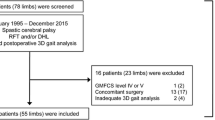Abstract
Background
Selective tibial neurotomy (STN) is an effective neurosurgical intervention for treating ankle spasticity. The authors use intraoperative electromyography (EMG) for selecting targeted fascicles and determining the degree of fascicular resection in STN. This study reports surgical techniques and outcomes of the operation.
Methods
Participants who underwent STN with utilization of intraoperative EMG were recruited. Modified Ashworth Scale (MAS), passive range of motion (PROM) of the ankle in plantar flexion and dorsiflexion, Massachusetts General Hospital Functional Ambulatory Classification (MGHFAC) and ability to attain full plantigrade stance were assessed pre- and postoperatively.
Results
Twenty-one STNs were performed in 15 patients. The mean pre- and postoperative MAS and PROM were 2.8 and 0.4 (p < 0.001), 39.5o and 66.0o (p < 0.001), respectively. The mean level of MGHFAC was improved from 3.3 preoperatively to 4.9 postoperatively (p < 0.01). Six non-ambulators had significant amelioration in MGHFAC level. Postoperatively, 19 of 21 lower limbs achieved full plantigrade, and 6 patients could perform selective voluntary motor control of the ankle.
Conclusion
STN is an effective procedure for spastic ankle in well-selected cases. Intraoperative EMG helps in selection of targeted fascicles, increases objectivity in neurotomy and prevents excessive denervation.




Similar content being viewed by others
References
Bleyenheuft C, Detrembleur C, Deltombe T, Fomekong E, Lejeune TM (2008) Quantitative assessment of anaesthetic nerve block and neurotomy in spastic equinus foot: a review of two cases. J Rehabil Med 40:879–881
Bohannon RW, Smith MB (1987) Inter-rater reliability of a modified Ashworth scale of muscle spasticity. Phys Ther 67:206–207
Bollens B, Deltombe T, Detrembleur C, Gustin T, Stoquart G, Lejeune TM (2011) Effects of selective tibial nerve neurotomy as a treatment for adults presenting with spastic equinovarus foot: a systematic review. J Rehabil Med 43:277–282
Buffenoir K, Roujeau T, Lapierre F, Menei P, Menegalli-Boggelli D, Mertens P, Decq P (2004) Spastic equinus foot: multicenter study of the long-term results of tibial neurotomy. Neurosurgery 55:1130–1137
Decq P, Filipetti P, Cubillos A, Slavov V, Lefaucheur JP, Nguyen JP (2000) Soleus neurotomy for treatment of the spastic equinus foot. Groupe d'Evaluation et de Traitement de la Spasticité et de la Dystonie. Neurosurgery 47:1154–1160
Decq P, Filipetti P, Feve A, Djindjian M, Saraoui A, Kéravel Y (1997) Peripheral selective neurotomy of the brachial plexus collateral branches for treatment of the spastic shoulder: anatomical study and clinical results in five patients. J Neurosurg 86:648–653
Decq P, Shin M, Carrillo-Ruiz J (2005) Surgery in the peripheral nerves for lower limb spasticity. Oper Tech Neurosurg 7:136–146
Holden MK, Gill KM, Magliozzi MR (1986) Gait assessment for neurologically impaired patients. Standards for outcome assessment. Phys Ther 66:1530–1539
Lorenz F (1887) Uber cirurgische Behandlung der angeborenen spastischen Gliedstarre. Wien Klin Rdsch 21:25–27
Mertens P (2009) Neurosurgery for spasticity. In: Sindou M (ed) Practical handbook of neurosurgery from leading neurosurgeons. Springer Wien, New York, pp 365–386
Rousseaux M, Buisset N, Daveluy W, Kozlowski O, Blond S (2009) Long-term effect of tibial nerve neurotomy in stroke patients with lower limb spasticity. J Neurol Sci 278:71–76
Sindou M, Mertens P (2009) Destructive neurosurgical procedures for spasticity. In: Lozano AM, Gildenberg PL, Tasker RR. Textbook of stereotactic and functional neurosurgery. Springer-Verlag Berlin Heidelberg, pp 1935-1957
Sindou MP, Mertens P (2005) Decision-making for neurosurgical treatment of disabling spasticity in adults. Oper Tech Neurosurg 7:113–119
Sindou MP, Simon F, Mertens P, Decq P (2007) Selective peripheral neurotomy (SPN) for spasticity in childhood. Childs Nerv Syst 23:957–970
Sitthinamsuwan B, Chanvanitkulchai K, Phonwijit L, Nunta-aree S, Kumthornthip W, Ploypetch T (2012) Improvement of sitting ability and ambulation status after selective peripheral neurotomy of the sciatic hamstring nerve together with obturator branches for severe spasticity of the lower extremities. Stereotact Funct Neurosurg 90:335–343
Sitthinamsuwan B, Nunta-aree S (2010) Functional peripheral nerve surgery. Siriraj Med J 62:106–111
Sitthinamsuwan B, Nunta-Aree S, Nitising A, Tabtimsuwan S (2010) The neurosurgical treatment of spasticity—an overview. Neurol Surg 1:44–60
Sitthinamsuwan B, Parnnang C, Nunta-Aree S, Chankaew E, Papatthanaporn A (2010) An innovation of intraoperative electrical nerve stimulator. Neurol Surg 1:65–82
Sitthinamsuwan B, Phonwijit L, Nunta-aree S (2012) Current advance in neurosurgery for the peripheral nerve—Part I: fundamental anatomy, intraoperative nerve monitoring and classification of peripheral nerve surgery. Neurol Surg 3:33–48
Sitthinamsuwan B, Phonwijit L, Ploypetch T (2011) Neurosurgical management for cerebral palsy—part I: neuroablation. J Thai Rehab Med 21:73–84
Wangjam KB, Joy Singh AK, Romi Singh N, Nilachandra L, Bimol N (2011) EMG guided selective tibial neurectomy in reduction of gastro-soleus spasticity—its role in the treatment of cerebral palsy. Indian J Phys Med Rehabil 12:1–5
Conflicts of interest
None.
Author information
Authors and Affiliations
Corresponding author
Additional information
Comment
Botulinum toxin injection is presently the most commonly used procedure to treat focal spasticity. Nonetheless, many different strategies have been adopted throughout the history of neurosurgery, including section, lesions, drug infusion and stimulation of the entire neuraxis.
The first successful treatment was the section of the obturator nerve by Lorenz in 1897. These types of peripheral nerve operations continue to be useful and have been made more effective by employing intraoperative EMG monitoring. In their well-written and concise article, the authors clearly illustrate their surgical procedure and results. The article also demonstrates the efficacy of this procedure and its utility in specific situations. In fact, non-destructive neuromodulation procedures, in particular pump implantation for intrathecal baclofen administration, have the important characteristics of being adjustable and reversible, but are in general indicated for adult patients with diffuse cerebral of spinal spasticity. Selective peripheral neurotomies remain effective treatment options indicated for focalized spasticity in the limbs, in particular when harmful spasticity affects one or a few muscular groups and after treatment with botulinum toxin injections has been tried and revealed insufficient.
Alfredo Conti
Messina, Italy
Rights and permissions
About this article
Cite this article
Sitthinamsuwan, B., Chanvanitkulchai, K., Phonwijit, L. et al. Utilization of intraoperative electromyography for selecting targeted fascicles and determining the degree of fascicular resection in selective tibial neurotomy for ankle spasticity. Acta Neurochir 155, 1143–1149 (2013). https://doi.org/10.1007/s00701-013-1686-0
Received:
Accepted:
Published:
Issue Date:
DOI: https://doi.org/10.1007/s00701-013-1686-0




